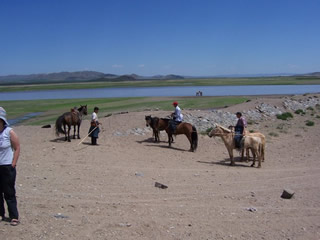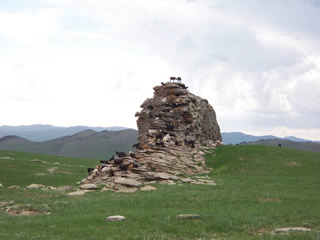
Mongolia LEWS: Livestock Early Warning System
Preparing pastoralists and decision-makers with critical, timely information in the face of drought
Early warning for livestock in Mongolia’s Gobi Region

During the period from 1999 to 2002, Mongolia experienced a series of droughts and severe winters that lowered livestock numbers by approximately 30% countrywide. In the Gobi region, livestock mortality reached as much as 50% with many households losing entire herds. Due to these extreme losses of livestock and its impact on pastoral livelihoods, the USAID mission in Mongolia and the Global Livestock-CRSP (GL-CRSP) initiated the Gobi Forage program with the goal of transferring Livestock Early Warning System (LEWS) technology developed by the GL-CRSP in East Africa to Mongolia. The Livestock Early Warning System technology combines near real-time weather, computer modeling, and satellite imagery to monitor and forecast livestock forage conditions so that pastoralists and other decision-makers have needed information for timely decision making in the face of drought. Under the Gobi Forage program, three major activities have been conducted:
- infusion of forage monitoring technology to assess regional forage quantity.
- development of nutritional profiling technology to assess forage quality.
- information delivery and outreach.
Implementing forage monitoring
Through the GL-CRSP program, Texas A&M University and Mercy Corps partnered to implement the forage monitoring technology in 8 aimags (provinces) that encompass the area where previous drought impacts were greatest. A series of 297 monitoring sites have been established across the region to provide inputs to the computer modeling and ground-truth data. Computer model simulations are developed for each monitoring site and are driven by climate data (rainfall and temperature) provided by the US National Oceanic and Atmospheric Administration (NOAA) to predict forage availability. This information is then combined with satellite greenness imagery (Normalized Difference Vegetation Index) provided by the National Aeronautics and Space Administration (NASA) to produce regional maps of forage production. These regional maps provide a spatial and temporal assessment of forage conditions and can highlight areas of significantly low forage availability. A sophisticated statistical forecasting technique is used to predict forage conditions for 60 days into the future. The current and forecast forage maps can be compared to long-term average maps to allow herders and decision makers to assess how bad or good conditions are compared to the average, and the level of risk they are willing to accept based on projected forage conditions. Map validation has indicated an overall accuracy level of 70% and successful identification of drought-stricken areas in the Dundgobi and Gobi Altai aimags in 2007.
Nutritional profiling with Near-Infrared Reflectance Spectroscopy, NIRS
The nutritional profiling technology has been implemented to allow near-real-time assessment of forage quality. Knowledge of forage quality is especially important in Mongolia given the short growing season and the extremely cold winter months that can lead to loss of body condition if animals have poor quality forages. The nutritional profiling technology uses Near-Infrared Reflectance Spectroscopy (NIRS) to scan the manure of livestock. These scans examine the reflectance of near-infrared wavelengths and compare them to wavelengths from known diets of livestock, therefore allowing a prediction to be made about the amount of protein and digestibility of the forage. This information can then be used in a computer model to determine whether the animal is losing or gaining weight and what forage or supplements can be fed to the animal to allow it to maintain weight or nurse offspring. As part of Gobi Forage, a laboratory has been established in Mongolia for conducting nutritional profiling and a mobile laboratory is being tested to allow this technology to be brought directly to herders. The NIRS technology is also being examined for several value-added analyses such as feedstuff quality, and cashmere and wool grading.
Information delivery successes

The Gobi Forage program has made significant progress in the information delivery and outreach for Gobi Forage products. Current, forecast and long-term deviation forage maps are produced bi-monthly and are distributed via http://www.mongolialews.net/ and email. The maps are also printed in color and mailed to soum (district) governments for local government use and for posting on the local government bulletin boards. Radio bulletins are produced weekly and reported on Mongolian National Public Radio. A recent survey in the region has indicated that the program has been exceedingly well received, with over 70% of herders having some degree of familiarity with Gobi Forage products. Almost half of the surveyed herders reported that they had used Gobi Forage information to guide livestock movements (51%), provide supplemental feed (49%) or change their rotational grazing strategy (40%). Almost one-third reported a net profit resulting from these actions. An overwhelming majority (93%) of government officials found Gobi Forage products to be very useful in advising herders on grazing management and livestock movement. One provincial governor described how the system helped him manage the influx of almost 50,000 herders and their families from a neighboring drought-stricken aimag and prevent conflict with local herders.
The future
The Gobi Forage program is now in the process of becoming institutionalized in Mongolia to incorporate the program within a national government research and extension agency. Discussions are also underway with the World Bank to acquire funding to maintain the current system and expand it to the entire country. The expansion of the program, as well as institutionalization in a Mongolian government agency, will build the foundation for long-term sustainability of the system and make these GL-CRSP forage monitoring technologies available to all Mongolians.
